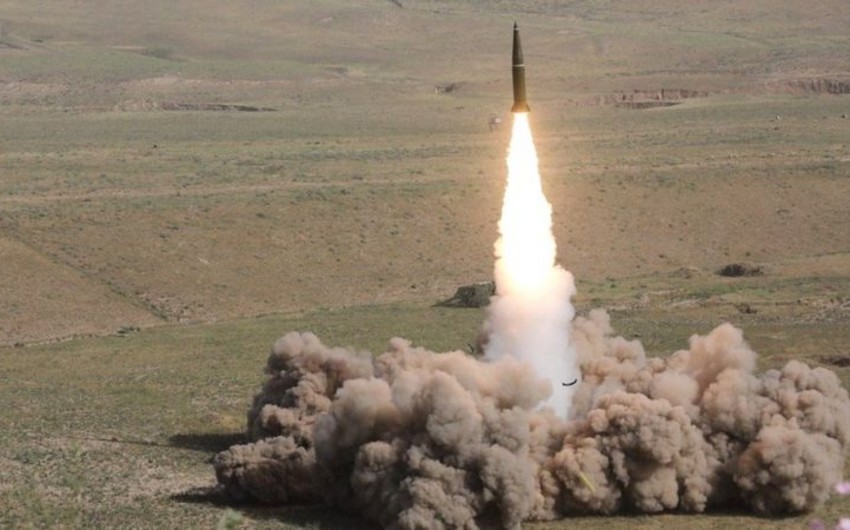BBC News Ukraine has published an article on the use of Iskander missile systems during the war in Karabakh.
Report presents this article:
"Azerbaijan claims to have discovered the wreckage of Russian Iskander missiles in Karabakh.
Moscow insists that these weapons were not used in the recent war.
Two rockets in Shusha
On Friday, Azerbaijan National Agency for Mine Action(ANAMA) demonstrated the wreckage of two missiles in Baku. It is claimed that these are fragments of Iskander missiles found in the city of Shusha on March 15 during mine clearance.
The city of Shusha is the most important strategic point, after the loss of which Yerevan agreed to the proposed ceasefire plan.
ANAMA representative showed photos of the rocket wreckage. According to him, now experts are clarifying their modification.
"The wreckage was located at a distance of 780 meters from each other. A recent investigation showed that an Iskander-M missile was fired in the direction of the city of Shusha, " said Chief of the Operational Headquarters of the ANAMA Idris Ismayilov.
According to him, the verification of the identification number of the missile (9M723) established that the wreckage belongs to the Iskander missile system.
Chief of the General Staff of the Armenian Armed Forces Artak Davtyan declined to comment on these reports: "I can't say anything because the information is not subject to disclosure."
Kremlin spokesman Dmitry Peskov, commenting on Baku's statements, reiterated that the Iskander missile systems were not used in the Karabakh conflict.
"As far as I understand, this is new information," he told reporters.
Judging by the markings, Azerbaijani media also draw attention to the fact that the missiles fired were not an export option - that is, they were intended for use by the Russian military.
Moreover, Idris Ismailov said that the exact models of the missiles are still being specified.
Peskov, in response, reminded reporters about the situation with the Iskanders: "You remember the story with the Iskander, that they were not used during the conflict, and this was confirmed."
We are talking about a scandal that aggravated the political crisis in Armenia and led to early elections.
Armenian Prime Minister Nikol Pashinyan said that Iskander missiles did not explode or only exploded by 10% during the fighting in Nagorno-Karabakh. He reacted to the former President of the country, Serzh Sargsyan, who said that the Armenian military could use Iskander at the very beginning of hostilities.
The Pashinyan administration later called his statement erroneous, explaining that the prime minister was incorrectly informed.
Dmitry Peskov was also asked if the Kremlin has any idea where the Iskander missile could come from: "No, we have no information," said a Kremlin spokesman.
In February, the Russian Defense Ministry said none of the Iskander missile systems were used during the conflict in Nagorno-Karabakh.
"According to the objective and reliable information that we have, confirmed by the system of objective control, none of the missile systems of this type were used during the conflict in Nagorno-Karabakh. All missile ammunition is in the warehouses of the Armed Forces of the Republic of Armenia," Russian Defense Ministry stated.
By the statement, Armenia received from Russia an export version of the Russian operational-tactical missile system "Iskander-M."
Ukrainian journalist Roman Bochkala, who was in Nagorno-Karabakh not so long ago, wrote that the detected missiles could cause a "loud scandal" because the launch of rockets at Shusha "looks like the work of Russia."
BBC News correspondent Grigor Atanesyan:
"The new data provided by Azerbaijan National Agency for Mine Action (ANAMA) contradicts the Russian Defense Ministry's statements, which denied the very fact of the use of Iskanders by Armenia."
However, Baku's statements are not the first and not the only evidence of Armenia's use of these complexes.
Indirect traces of their use appeared in the last days of the war.
On November 9, a few hours before the leaders of Azerbaijan, Armenia and Russia signed a ceasefire, a video appeared on social networks showing Armenian soldiers in front of a launcher, from which two missiles fly out with a difference of 41 seconds.
Local journalists emphasize that Iskander-E (export version of Iskander) is the only system in Armenia's arsenal capable of firing missiles with such a frequency.
Besides, back in November, a source in the Armenian government told BBC News about the use of Iskanders in the last days of the war. Colonel-General of the Armenian army Movses Hakobyan also spoke about using these operational-tactical missiles without providing evidence.
This topic remained in the zone of interests of military experts by the end of February-until Nikol Pashinyan stated that "the Russian Iskander missiles used during the war" exploded or exploded by 10%."
These words caused anger in Moscow. Soon, the Russian Defense Ministry said that " Iskanders were not used in Karabakh, and Pashinyan was misled."


 https://static.report.az/photo/54ffced0-af40-3a0a-bb7d-7414ee258863.jpg
https://static.report.az/photo/54ffced0-af40-3a0a-bb7d-7414ee258863.jpg

